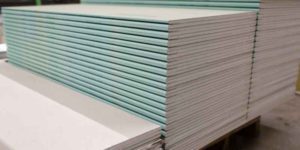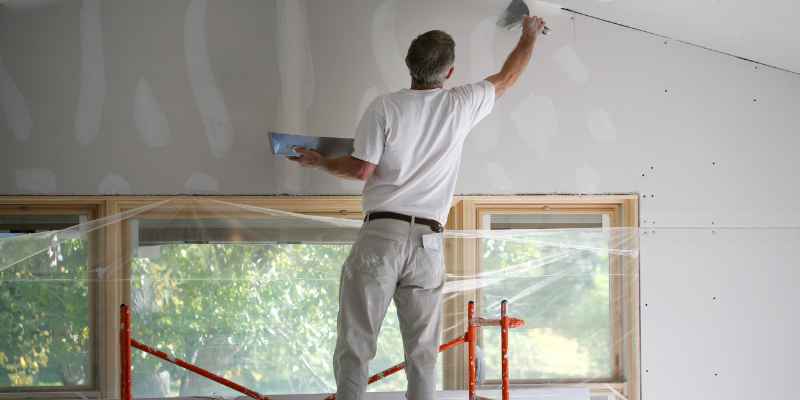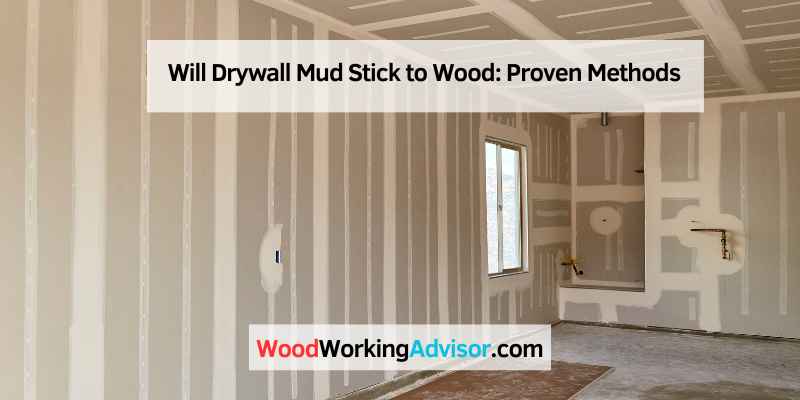Drywall mud will adhere to wood, making it possible to use on plywood surfaces with proper preparation. When applying drywall mud to wood, ensure the surface is rough-grain or painted in a non-glossy finish for better adhesion.
Plywood and oriented strand board are ideal choices for applying drywall mud, while painted wood surfaces must be flat for successful application. Drywall mud should not be used for outdoor projects due to its intended indoor use. Properly preparing the wood surface before applying drywall mud is crucial to achieving a durable and smooth finish.
Understanding Drywall Mud
Drywall mud can indeed stick to wood surfaces, including plywood and painted wood, as long as the surface is rough-grained and not glossy. It’s important to note that drywall mud, although designed for use on drywall, can be applied to wood with proper adhesion and even drying.
Composition Of Drywall Mud
Drywall mud, also known as joint compound, comprises gypsum and glue for improved adhesion. It serves as a versatile material for taping, finishing seams, and filling holes in drywall.
Purpose Of Drywall Mud
Drywall mud is designed to create a smooth and seamless finish on drywall surfaces. It can also be applied to wood, such as plywood or rough-grain surfaces, for filling imperfections and creating a uniform texture.
Applying Drywall Mud On Wood
Applying drywall mud on wood can be a useful technique for achieving a smooth surface and concealing imperfections. It is a common practice in carpentry and woodworking, where drywall mud is applied to wooden surfaces to prepare them for painting or finishing.
However, it is essential to ensure proper adhesion of the drywall mud to the wood to achieve the desired results. In this article, we will explore the factors influencing the adhesion of drywall mud to wood and methods to ensure a successful application.
Can Drywall Mud Stick To Wood?
Drywall mud can indeed adhere to wood surfaces, but certain considerations need to be taken into account to ensure optimal adhesion. Wood, especially if it’s smooth, may pose challenges for the drywall mud to adhere properly. Factors such as the type of wood, surface preparation, and the application technique play a crucial role in determining the adhesion of drywall mud to wood.
Methods To Ensure Adhesion
-
Surface Preparation: The wood surface should be clean, dry, and free from any contaminants that may hinder adhesion, such as grease, dirt, or old finishes. Sanding the wood to create a rough texture can enhance the bond between the drywall mud and wood.
-
Priming the Wood: Applying a suitable primer before applying the drywall mud can promote better adhesion and prevent the wood from absorbing moisture from the mud, which could lead to warping or swelling.
-
Using the Right Type of Drywall Mud: Choosing a drywall mud specifically designed for use on wood surfaces can optimize adhesion. Some formulations are tailored to bond effectively with wood substrates.
-
Application Technique: Employing proper application techniques, such as distributing the mud evenly, feathering the edges, and allowing adequate drying time, can contribute to a more secure bond between the drywall mud and wood.
By adhering to these methods, the adhesion of drywall mud to wood can be greatly improved, resulting in a flawless finish that meets the desired aesthetic and functional requirements.

Potential Issues With Drywall Mud On Wood
Drywall mud, also known as joint compound, can be used on wood surfaces for various purposes, such as filling nail holes, repairing damage, or creating a smooth finish. However, there are potential issues that need to be considered when applying drywall mud to wood. Some of the key concerns include dimensional changes in wood, cracking over time, and adherence of the mud to the wood surface.
Dimensional Changes In Wood
Wood is susceptible to dimensional changes due to fluctuations in humidity and temperature. Drywall mud, being a water-based material, can absorb moisture from the wood, causing it to expand and contract. This may lead to cracking and delamination of the mud from the wood surface over time.
Cracking Over Time
As the wood underneath the drywall mud naturally expands and contracts, the mud layer applied on top can develop cracks. These cracks may compromise the overall integrity and aesthetics of the finish. Additionally, the bonding between the mud and wood may weaken, leading to flaking or peeling of the mud layer.
It’s important to consider these potential issues before using drywall mud on wood to ensure that the application is properly executed and that appropriate measures are taken to mitigate any adverse effects.
Alternatives To Drywall Mud On Wood
When considering alternatives to drywall mud on wood, there are various options that can achieve similar results with different materials.
Using Wood Fillers
Wood fillers are an excellent alternative to drywall mud on wood surfaces. They come in different formulations to match various wood types and can be stained or painted to blend seamlessly with the wood.
Other Materials For Wood Filling
Other materials such as epoxy putty, wood putty, or spackling paste can also be used for filling gaps and cracks on wood surfaces. These materials offer durability and adhesion to wood.
Recommended Uses Of Drywall Mud On Wood
Drywall mud can effectively stick to wood surfaces such as plywood or painted wood if applied to a rough-grain texture. While originally designed for drywall, it can be used on wood with proper adhesion techniques to create a smooth finish.
Filling Small Holes And Cracks
Drywall mud is an excellent option for filling small holes and cracks in wood. Whether you’re working on furniture repair or home improvement projects, drywall mud can come in handy. Its smooth texture allows it to be easily applied to the surface, ensuring a seamless finish. To fill small holes and cracks with drywall mud, follow these simple steps:
- Clean the wood surface thoroughly, removing any dust, debris, or loose particles.
- Using a putty knife, apply a small amount of drywall mud to the hole or crack, ensuring it is completely filled.
- Smooth out the surface of the mud using the putty knife, creating an even and level finish.
- Allow the mud to dry completely, usually overnight.
- Once dried, sand the filled area gently to achieve a smooth and seamless look.
- Wipe away any excess dust and debris, and the wood is ready for further finishing or painting.
Creating A Textured Finish
Another recommended use of drywall mud on wood is to create a textured finish. This technique is particularly popular in interior design and furniture restoration projects where a unique and visually appealing look is desired. With drywall mud, you can easily achieve different textures such as stippling, swirls, or knockdown patterns. Follow these simple steps to create a textured finish on wood:
- Prepare the wood surface by cleaning it thoroughly and ensuring it is smooth and free from imperfections.
- Using a putty knife or a texture tool, apply a generous amount of drywall mud onto the wood surface.
- Experiment with different techniques to create the desired texture, such as stippling or swirling motions.
- Allow the textured mud to dry completely, typically overnight.
- Sand the textured surface gently to achieve a smooth and consistent finish.
- Finally, seal and protect the textured surface with an appropriate wood finish or paint.
Remember, when using drywall mud on wood, it is essential to ensure proper adhesion by cleaning the wood surface beforehand and taking necessary steps to seal and protect the finished work. With the recommended uses of drywall mud on wood, you can easily fill small holes and cracks or create stunning textured finishes on your next woodworking or DIY project.

Tips And Tricks For Using Drywall Mud On Wood
Using drywall mud on wood can be a great solution for filling holes, repairing damaged surfaces, or creating a smooth finish on wood projects. However, there are a few things to keep in mind to ensure a successful application. In this guide, we will discuss some tips and tricks for using drywall mud on wood, including choosing the right type of drywall mud and preparing the wood surface.
Choosing The Right Type Of Drywall Mud
When it comes to using drywall mud on wood, it’s important to choose the right type of product. There are different types of drywall mud available, such as lightweight joint compound, all-purpose joint compound, and setting-type joint compound. Each type has its own unique properties and is suitable for different applications.
If you’re working on a small project or need fast drying time, a lightweight joint compound or setting-type joint compound may be the best choice. On the other hand, if you’re looking for versatility and ease of use, an all-purpose joint compound would be a good option.
Preparing The Wood Surface
Before applying drywall mud to wood, it’s important to properly prepare the surface. This ensures that the mud adheres properly and provides a smooth finish. Here are some steps to follow while preparing the wood surface:
- Clean the surface: Remove any dirt, dust, or debris from the wood surface using a soft brush or vacuum cleaner.
- Repair any damage: Fill any holes or cracks in the wood using wood filler or putty. Allow the filler to dry completely before proceeding.
- Sand the surface: Use sandpaper to smooth the wood surface and create a slightly rough texture. This will help the drywall mud adhere better.
- Prime the wood: Apply a coat of primer to the wood surface. This will create a barrier between the wood and the drywall mud, ensuring better adhesion.
By following these steps, you can ensure that the drywall mud adheres properly to the wood surface and provide a smooth and durable finish.
In conclusion, using drywall mud on wood can be a great way to fill holes, repair damage, and create a smooth finish. By choosing the right type of drywall mud and properly preparing the wood surface, you can achieve excellent results. Remember to always follow the manufacturer’s instructions for the specific drywall mud product you’re using. Happy woodworking!
Frequently Asked Questions Of Will Drywall Mud Stick To Wood
Can You Use Drywall Mud On Wood?
Yes, you can use drywall mud on wood. Drywall mud, also known as joint compound, can be applied to wood surfaces for filling holes and smoothing. It is important to note that drywall mud is specifically designed for drywall, so additional steps may be required to ensure proper adhesion and drying on wood.
Will Drywall Mud Adhere To Plywood?
Drywall mud can adhere to plywood, but it’s important to note that drywall mud is specifically designed for use on drywall. Applying it to plywood may require additional steps to ensure proper adhesion and even drying.
Can I Use Drywall Compound As Wood Filler?
Yes, you can use drywall compound as wood filler because it contains gypsum and is suitable for filling holes in wood.
Will Drywall Plaster Stick To Wood?
Yes, drywall plaster can stick to wood, but the bond may weaken over time due to wood’s dimensional changes from humidity.
Conclusion
Drywall mud can indeed adhere to wood surfaces, providing a versatile solution for various projects. However, it’s essential to consider the type of wood and proper preparation techniques to ensure a strong bond. With appropriate application and care, drywall mud can be a valuable option for woodworking endeavors.


